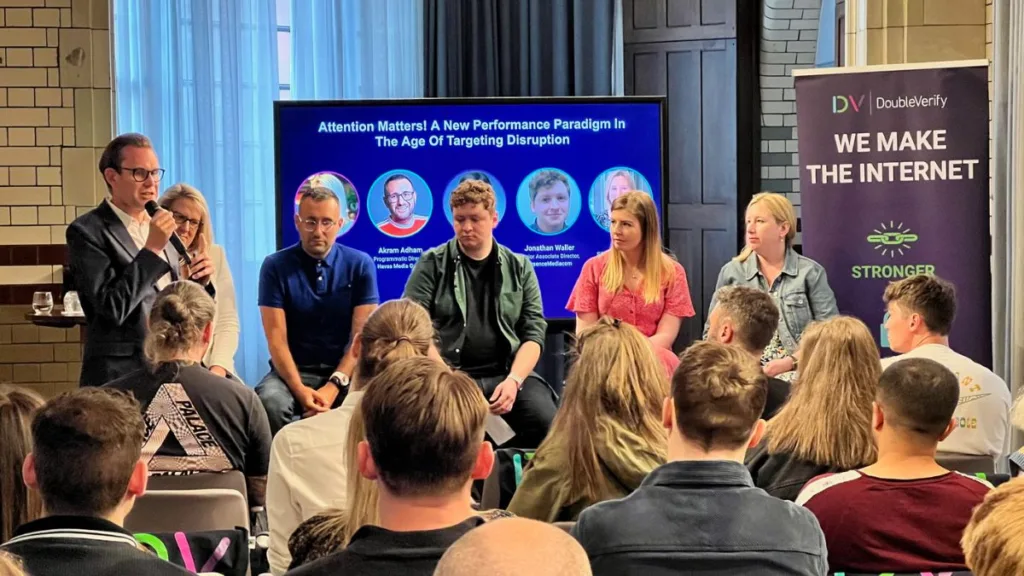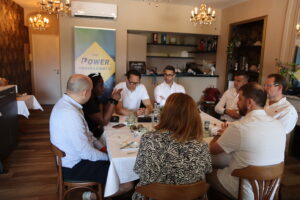We’ve all heard the old head-scratcher – if a tree falls in the forest and no-one is around to hear it, does it make a sound? Digital ads find themselves with a similar quandary. If a digital ad lands on a website, but no one’s really paying attention, did it make an impact? Common sense would dictate the answer is no. And yet, by many current measurement standards, as long as it was present and viewable, it did its job.
The value of digital advertising is always hotly debated. NDA, in partnership with DoubleVerify, hosted a panel discussion for an audience of northern media agencies and advertisers to examine the industry’s growing interest in attention as a metric, and how important it will be to evolve measurement and the determining factors of campaign performance, if advertisers are to deliver impactful and valuable ads in an increasingly privacy-focused world.
The panel discussion featured Akram Adham, Programmatic Director, Havas; Ashley Bateman, Group Director, DoubleVerify; Liz Emerick, Biddable Business Director, PHD Media; Rose Silford-McLoughlin, Programmatic Partner, dentsu; Jonathan Waller, Senior Associate Director, Digital Investment, essence mediacom; and Joseph McKenna, Executive Director, Digital UK, mSix&Partners.
“Attention is a really big topic as we move into a privacy-protected world,” opens Rose Silford-McLoughlin, Programmatic Partner, dentsu. “We’re moving away from third-party audiences, measurement is becoming more difficult. We have to measure effectively in a cookieless environment.”
While the shift away from third-party cookies and cookies may seem more effortful for the advertiser, it should also ideally deliver more effective ads, with better customer experience. For some industries, the first-party route has been the only real option.
“A few of my clients rely heavily on first-party data to generate 90% of their audience,” reveals Jonathan Waller, Senior Associate Director, Digital Investment, essence mediacom. “Cancer Research for example, is an extremely emotional business in many respects so there’s not a lot of third-party data out there that immediately answers the question of who would want the product. First-party data was always really crucial.”
The move to first-party data is going hand in hand with contextual advertising, making the most of the content rather than necessarily granular data – and in many cases both combined – to deliver relevant ads that capture the consumer’s attention effectively.
“We’ve tried to be proactive with our clients to transition to cookieless approaches and contextual because we know that’s going to be important. Clients like the BBC have an abundance of first-party data so we’re very keen to make sure we explore that with them,” says Akram Adham, Programmatic Director, Havas.
“CRM integration, multiple partners and leveraging the DMP can help us really understand how to futureproof our activity. With an abundance of rich first-party data there are so many things we can do to expand the audience, leverage the media to complement them and be agile with our activities,” he adds.
It all sounds so simple, but it quickly becomes clear that we are heading into complex waters. Contextual advertising and first-party data may fuel ads that capture attention more effectively than ever before, but this then makes much greater demands of measurement.
Ashley Bateman, Group Director, DoubleVerify, notes: “In attention alone, we measure 50 different metrics. Media verification has come a long way. It was seen as a tick box exercise but now people are using all the metrics that are available to drive outcomes and performance – for example, making sure there are no fraudulent impressions, that it’s viewable and that it’s within a brand-suitable environment.”
The number of potential metrics is compounded by the fact that there is both no set formula for measuring attention, and yet there is a desperate need to create some kind of order. Liz Emerick, Biddable Business Director, PHD Media notes “measurement isn’t a one-size-fits-all approach” but adds that “we need a framework considering multiple metrics to get a good measure of our media”.
The final string to the attention measurement bow is the advertising ecosystem. It’s not enough to simply measure your own slice of the pie. You have to take into account everyone’s contribution. “It’s important to have a consistent feedback loop,” Bateman insists. “We have all that information within our Pinnacle platform and it gets sent to the media agency but doesn’t go to the advertiser. The advertiser has to understand the performance of their media investments and you need to involve the creative agency as well.” Feeding the supply chain is going to be key if attention is to make sense as a metric.
It may sound like a lot of effort where current methods seem to work for many advertisers. “Some clients will say they’re happy with the way things are. They can base their business around higher level brand awareness and consideration metrics. They’re not willing to jump into a new way of looking at things until they’re forced – which is challenging,” Waller admits. Adham adds that shining a light into more effective ad verification is important if agencies are to shore up any trust issues: “Without predefined values it’s hard to go out and say ‘this is what we do’ without people thinking it’s all smoke and mirrors.”
The shift to attention could potentially have far-reaching impacts, fundamentally changing how advertisers, their agencies and creative partners plan their communications, as well as making it interesting for media owners too. In part two of our briefing round-up, attendees debate how to deal with the omnichannel smorgasbord, taking a peek into the walled gardens and asking if a drive towards sustainability might be the push some laggards need to take the attention leap.








